Listen up; workshops are noisy. Make sure you protect your ears with one of these top products in hearing protection.
BobVila.com and its partners may earn a commission if you purchase a product through one of our links.
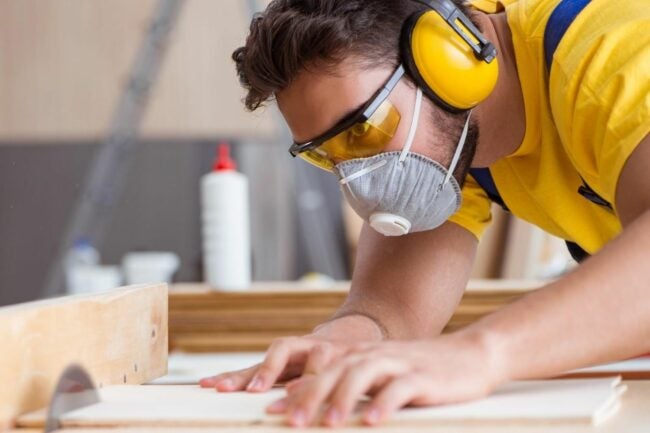
Photo: Depositphotos. com
If you spend a lot of time in your workshop, you’re undoubtedly making a bit of a racket. While you may know how important it is to protect your eyes, you may still focus less on using the best hearing protection to safeguard your ears.
Tools are great for fixing and building, but they’re tough on your body. Power tools like circular saws, miter saws, and air compressors can wreak havoc in your ears. Loud noises damage the sensitive cells in your ears, and eventually, those cells will die. Instead of letting your hearing slip away, keep loud noises from blasting your ears with some of the best hearing protection.
- BEST OVERALL: 3M Pro-Grade Noise-Reducing Earmuff
- BEST BANG FOR THE BUCK: 3M Peltor X2A Over-the-Head Ear Muffs
- BEST HEAVY-DUTY: 3M PELTOR EEP-100 Ear Plug Kit
- BEST BLUETOOTH: 3M WorkTunes Connect Hearing Protector with Bluetooth
- BEST EARPLUGS: SureFire EP4 Sonic Defenders Plus filtered Earplugs
- BEST SEMI-INSERT EARPLUGS: Howard Leight by Honeywell Quiet Band Foam Earplugs
- MOST COMFORTABLE: Mack’s Ultra Soft Foam Earplugs
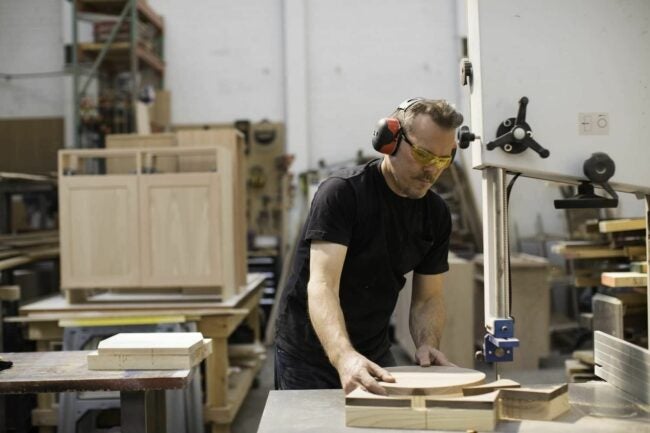
Photo: amazon.com
Types of Hearing Protection
When it comes to protecting your hearing, there are a lot of products on the market in many different styles. Some of these options are more comfortable than others, while some have features, like reusability, that might appeal to you. The following are the most common types of hearing protection.
Earplugs
If you’ve ever seen someone working with brightly-colored dots inside their ears, they were using earplugs.
These hearing protection products block the noise by closing off the ear canal completely, significantly reducing the decibel levels experienced by your ears. The plugs are usually a soft foam, which you roll between your fingers to compress. Once you place them in your ears, they expand and take the shape of your ear canal to prevent excessive noise from getting in. You can expect to reuse these plugs a few times throughout the day, but eventually, the foam breaks down from all the compressing.
There are also rubber earplugs, which look like little pine trees. These plugs are far more reusable, but may not offer the level of protection that foam plugs do.
Semi-Insert Earplugs
If you’re not a big fan of shoving plugs in your ears, you might prefer semi-insert earplugs. Instead of rolling and compressing these to fit inside of your ears, they use rigid headbands with rubber or foam plugs on the end. The headband creates just enough pressure to clamp the plugs in place over your ears, significantly reducing your exposure to loud noises without inserting a plug deep inside your ear canal.
The plugs are generally cone-shaped or rounded, providing a proper seal around the entrance of the ear and allowing you to reuse them time and time again. They’re great for your home workshop, as you can take them out of your ears and wear them around your neck while performing quieter tasks, and quickly throw them on when you’re firing up a power tool.
Over-the-Ear
Over-the-ear hearing protection allows you to protect your hearing without putting anything at all inside of your ears. Muff-style hearing protection uses rigid headbands to hold hard shells with soft foam pads over your ears. They keep abrasive noises from entering by creating a seal around the entire ear.
These muffs do an excellent job of protecting your hearing, but the foam can trap heat, and the shells can be a bit heavy. They’re indefinitely reusable unless the padding rips or deteriorates. They work well in a shop, but because they can be a little cumbersome, you’re less likely to keep them around your neck when not in use. This means you’ll have to find them when it’s time to make noise, which isn’t always convenient.
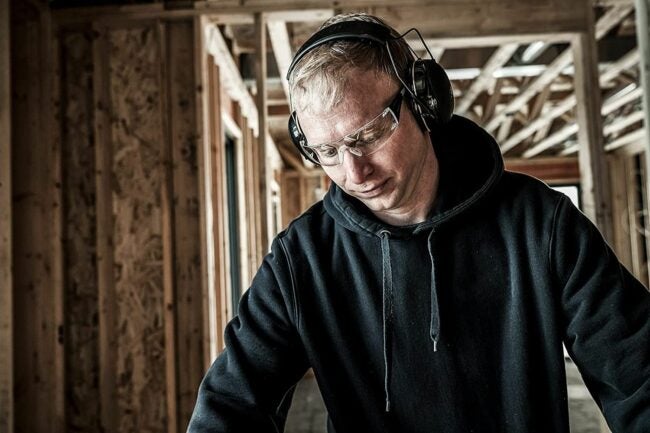
Photo: amazon.com
What to Consider When Buying Hearing Protection
The great thing about having so many options is that you can choose the best hearing protection for your personal needs. When deciding on a set of plugs or muffs, there are a few things worth keeping in mind. The following are some important considerations that will help you decide on the best hearing protection for your workshop.
Comfort
If your hearing protection isn’t comfortable, you’re not going to wear it. It’s essential to choose plugs or muffs that are comfortable in your ears and, if applicable, around your neck.
- If you’re okay with placing plugs in your ear canal, earplugs can be the most comfortable ear protection. They’re light, soft, and some come with a thin strap that you can use to wear them around your neck when not in use.
- Semi-insert earplugs are an ideal option for comfort if you’re not the foam earplug-type. The headbands only provide enough pressure to keep the plugs in your ears without creating discomfort. They’re light and easy to wear around your neck when they’re not in your ears.
- Over-the-ear muff-style hearing protection can be a bit clumsy, but if you have particularly sensitive ears, they may be the only style you find comfortable. It’s critical to find a pair that fit well but don’t create discomfort or make you overheat when worn around your neck.
Noise Reduction
A Noise Reduction Rating (NRR) describes how many decibels a particular product lowers noise. For instance, a product with a 30 NRR will reduce a 100dB noise level to 70dB.
Earplugs tend to have the best NRR. Some offer reductions as much as 33dB. The most you can get from a set of over-the-ear muffs is 31dB. If you combine both of these styles, you can create an NRR of 36dB.
If you’re wondering what level of NRR you need, it will depend on the work you’re doing. Circular saws run somewhere in the range of 90dB. To lower this to the accepted safe level of 70dB and below, you’ll need hearing protection with a 20 NRR or more. For an idea, here are some popular tools and the decibels they create:
- Circular Saws: 90dB
- Miter Saw: 102dB
- Router: 95dB
- Table Saw: 92dB
- Air Compressor: 40dB to 90dB
PPE Compatibility
Personal protective equipment (PPE) is incredibly important for many reasons, but these pieces aren’t always compatible with your hearing protection.
Earplugs are fairly universal, working with all PPE. Semi-insert plugs are slightly more of a challenge, as the headband could tangle with your respirator’s straps or safety glasses.
Over-the-ear muffs are the biggest challenge. They may not work with your respirator, mostly due to the neck-straps and the harness. Also, safety glasses that need to tuck underneath the muffs will create space for noise to sneak through, reducing the effective NRR rating of your muffs.
Temperature & Humidity
Temperature and humidity have less to do with effectiveness and everything to do with comfort. Due to the nature of hearing protection products, they aren’t breathable and can trap body heat. This isn’t an issue with earplugs or semi-insert plugs, but it’s a major concern with over-the-ear muffs.
Over-the-ear muffs trap lots of body heat, both in the shell and the headband (especially when worn around your neck). The thick foam and airtight coating don’t allow the muffs to breathe, which can be particularly uncomfortable in non-air-conditioned spaces like workshops or garages. If this describes your shop, consider using an earplug to stay cool and comfortable.
Communication & Audibility
While the ability to hear your surroundings may seem strange in an article about hearing protection, situational awareness can be equally important to staying safe in a workshop environment. If you work with other folks in your workshop, being able to hear them and understand can help increase your workflow and keep you safe.
If this is important to you, you could check into electronic hearing protection that detects and blocks dangerous decibel levels, while still allowing you to hear normal conversation and safe noises. These electronic plugs are a bit more expensive than standard options, but they can make a huge difference when working around other people.
Bluetooth
Music can increase your workflow, and it helps some people focus on the task at hand. It can be challenging to hear a stereo through your earplugs, however. A handy option is going for a Bluetooth enabled set of earplugs or muffs.
With Bluetooth plugs, you can tune into your favorite music app and enjoy the melodies while working the day away. They also protect your hearing from excessive noise levels. The same considerations apply as standard hearing protection, however, so they need to be comfortable and compatible with Personal Protective Equipment.
Additional Features
There are a few other things you might want to look for when shopping for the best hearing protection. When it comes to earplugs, you may prefer those that hang from a soft neck cord. Concerning ear muffs, you might consider finding something lightweight that won’t hang uncomfortably from your neck.
Our Top Picks
Now that you know what to look for, you should have a great idea of what type of the best hearing protection will work for your needs. The following is a list of the top products for protecting your hearing. Regardless of what you’re looking for, you’ll find a product on this list that will work for you.
Best Overall
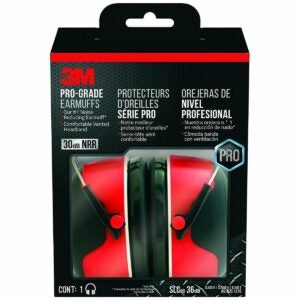
If you prefer over-the-ear protection, but have concerns about weight and overheating, the Pro-Grade Noise-Reducing Earmuff may be a good choice. These muffs use a rubber over-molded headband with ventilation to help keep you cool and comfortable, regardless if it’s on top of your head or around the back of your neck. They’re also lightweight and adjustable, providing a comfortable fit for all-day work conditions. If you do put them down, the red shells allow you to find them quickly amongst the other tools on your workbench. These Pro-Grade muffs provide an NRR of 30dB, maintaining safe decibel levels for tools up to 100dB.
Best Bang for the Buck
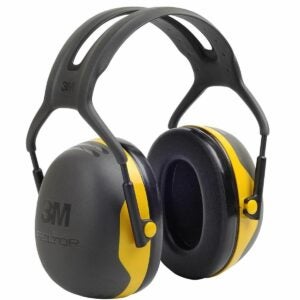
If you’re looking for a basic set of earmuffs to protect your hearing on a budget, you should check out the Peltor X2A Over-the-Head Ear Muffs from 3M. These earmuffs offer an NRR of 24dB, allowing you to protect your hearing in all but the loudest scenarios. The open headband uses two separate wires to allow for plenty of airflow, while the plastic cups are lightweight to reduce discomfort. The soft foam ear cushions create a tight seal while not being uncomfortable. Should those cushions start to deteriorate over time, you can replace them with the 3M Peltor X2 Hygiene Kit (available here).
Best Heavy-Duty
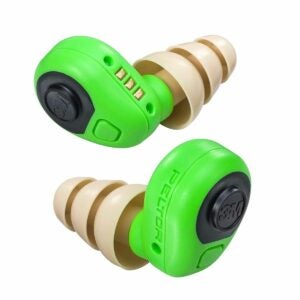
Construction sites are full of dangerous situations, and if you’re blocking your hearing off completely, you could end up in the middle of one. The 3M Peltor EEP-100 Ear Plug Kit is ideal for these heavy-duty situations. Outfitted with the correct earplugs (Triple C Ear Tips included), they provide an NRR of 27, protecting your ears from noises up to 97dB. Possibly just as important, they allow you to hear normal conversations, keeping you aware of what’s going on around you. A simple one-button on-off switch helps make these plugs easy to use and frustration-free. These rechargeable earbuds come with a storage case that also doubles as a charging station.
Best Bluetooth
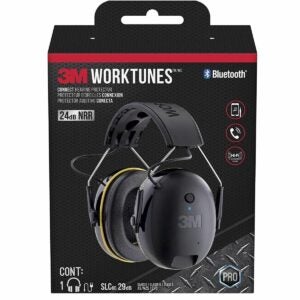
If you’re in the market for a pair of wireless Bluetooth headphones that let the good times roll without letting harmful noises reach your eardrums, check out the 3M WorkTunes Connect ear muffs. These muffs provide an NRR of 24dB, which is perfect for most workshop activities and allow you to stream media through your Bluetooth-enabled phone, tablet, or other devices. They also have a built-in microphone to enable you to take phone calls without removing your hearing protection—ideal for when your hands are busy finishing a project on a deadline. The high-fidelity speakers will produce high-quality audio, allowing you to enjoy your favorite album while you work in your shop.
Best Earplugs
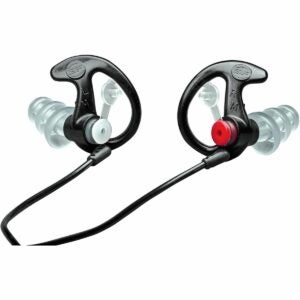
The EP4 Sonic Defenders are a nice combination of protection and convenience. Their filter plugs allow you to block off your ear canal, creating an NRR of 24 dB. However, you can also maintain a normal conversation when you remove the caps without removing the plugs from your ears. This means your earplugs will always be handy, and you don’t have to worry about keeping them clean when you take them out. If you do decide that you want to take them out during the day, they come with a detachable neckband to keep them in place during a break. They use a soft medical-grade polymer that makes them both comfortable and durable.
Best Semi-Insert Earplugs
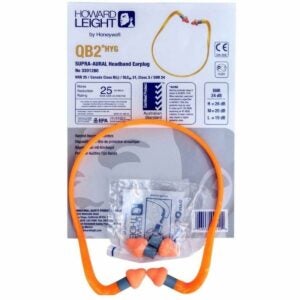
The Quiet Band Foam Earplugs from Howard Leight by Honeywell are a great option if you like the protection of an inner earplug but want the reusability of an over-the-ear system. This semi-insert earplug kit blocks off your ear canals with soft foam pods, while the headband keeps them in place, providing an NRR of 25dB. When you need to have a conversation, simply pull the plugs out of your ears and rest the headband around your neck. You’ll be able to converse normally while also keeping your earplugs clean, and within easy reach when it’s time to get back to work.
Most Comfortable
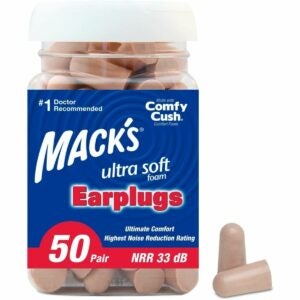
There are a lot of benefits to foam earplugs, and this pack of 50 will show you why. These foam earplugs create an NRR of 33dB, making them the most effective on our list, while also being exceptionally comfortable. You can wear these in the shop, or even to bed, as you’ll barely notice them once they’re in your ears. The soft foam rolls easily and expands inside of your ear canal, blocking off sounds. They’re also reusable, allowing you to keep them for two or three uses before they start breaking down. If you decide to double-up your hearing protection with a set of over-the-ear muffs, Mack’s earplugs soft foam will ensure that your ears stay comfortable while providing tons of NRR.
The Advantages of Owning the Best Hearing Protection
It’s not hard to damage your hearing. In fact, a single exposure to a loud noise can cause permanent damage. Imagine what exposing yourself to power tools day-in and day-out can do. Owning the best hearing protection for your shop will help preserve your hearing from years of damage.
Hearing protection that’s comfortable for you may not be comfortable for someone else. Purchasing the best hearing protection for your personal needs will ensure you use it instead of taking your plugs out or muffs off and setting them aside. After all, they won’t do you any good sitting on your workbench.
If your employer requires hearing protection, you can ensure that you have the best hearing protection you can get instead of using theirs. Often, employers purchase inexpensive PPE to meet particular insurance or OSHA requirements, and they’re likely to be inferior to a high-end product. Buying your own hearing protection will help you avoid damage allowed by cheap protection.
- You can protect your hearing from years of damage.
- You’ll be able to choose the perfect fit for your comfort needs.
- You can ensure you’re using high-quality hearing protection.
FAQs About Your New Hearing Protection
If you still have questions about the best hearing protection products, that’s perfectly understandable. There can be a lot riding on your choice, and it’s not a decision that should be made lightly. Here are some of the most common questions about hearing protection, along with some answers you might need.
Q. What is the best noise reduction rating?
One of the best hearing protection products regarding NRR are earplugs, and they provide up to 33dB of noise reduction. If you double them with an over-the-ear muff with an NRR of 31 (the maximum available), you can obtain a combination NRR of 36dB.
Q. What is a dangerous decibel level?
The widely accepted safe decibel level is anything less than 70dB. Above 70dB, you should consider wearing hearing protection to lower your chances of damaging your hearing.
Q. Which is better: in-ear or over-the-ear protection?
In-ear hearing protection does a better job of reducing noise, but over-the-ear protection is better than nothing. It’s largely dependent on what you’re comfortable with and what you’ll use. It doesn’t matter if in-ear plugs are better if you’re too uncomfortable to shove them in your ears.
tinyurlis.gdv.gdv.htclck.ruulvis.netshrtco.de
مقالات مشابه
- آموزش متاورس - امیدینو.ترید
- لوله پلیکا سایز بزرگ جداره چاه - مرجع بزرگ خرید و فروش لوله
- یک نکته برای بهبود شما (r) اسباب بازی
- شرکت صادرات و واردات کالاهای مختلف از جمله کاشی و سرامیک و ارائه دهنده خدمات ترانزیت و بارگیری دریایی و ریلی و ترخیص کالا برای کشورهای مختلف از جمله روسیه و کشورهای حوزه cis و سایر نقاط جهان - بازرگانی علی قانعی
- شرکت صادرات و واردات کالاهای مختلف از جمله کاشی و سرامیک و ارائه دهنده خدمات ترانزیت و بارگیری دریایی و ریلی و ترخیص کالا برای کشورهای مختلف از جمله روسیه و کشورهای حوزه cis و سایر نقاط جهان - بازرگانی علی قانعی
- چگونه یک چادر مسافرتی خوب انتخاب کنیم
- شرکت صادرات و واردات کالاهای مختلف از جمله کاشی و سرامیک و ارائه دهنده خدمات ترانزیت و بارگیری دریایی و ریلی و ترخیص کالا برای کشورهای مختلف از جمله روسیه و کشورهای حوزه cis و سایر نقاط جهان - بازرگانی علی قانعی
- تصادفی اسباب بازی نکته
- 11 روش برای مواد غذایی خود را بیشتر
- اسباب بازی بدون رانندگی خودت دیوانه